ESG Economist - Five climate challenges in Dutch climate sectors

This analysis shows that the emission reduction trend in sectors in the post-Paris period (2017-2023) would not – if it continued – lead to achieving the 2030 target. Indeed, following the post-Paris period trend in GHG emissions, the 2030 emissions reduction target (55% below 1990 level) will not be achieved, with a 5% gap. The recent analysis by the Netherlands Environmental Assessment Agency (PBL) even suggests that on the basis of current policies the post-Paris emission reduction trend will slow for many sectors.
Each climate sector has its own most pressing challenge, which ultimately exerts the most influence and impact on the reduction of GHG emissions
The biggest challenge for industry is that the pace in implementing low-carbon production techniques in energy-intensive industrial sectors is relatively slow
For agriculture, it is more complex to flag a single challenge, but low-carbon innovation and more sustainable agricultural production, while maintaining revenue models are high on the agenda
In the mobility sector, it is about accelerating the electrification of road transport and an increase in the deployment of new generation clean fuels in waterborne transportation and aviation
In the built environment, it is about scaling up in electrification and energy efficiency measures and accelerating innovation in low-carbon building materials
Finally, in the energy sector, it is important to remove bottlenecks to the deployment of clean power generation in the electricity mix in the Netherlands
Greening the energy mix in the Netherlands appears to be key to greening businesses in many other climate sectors and thus deserves the highest priority
On 31 December 2030, there will be a climate balance sheet to see which EU climate targets we have achieved and which we have not. This leaves just over six years to go, which is relatively short to achieve all climate ambitions. To get close to the 2030 climate target, both the private and public sectors must take meaningful climate action to reduce greenhouse gas emissions faster. In this analysis, we try to answer the question of what this path to that 2030 climate target looks like for five climate sectors: industry, agriculture, mobility, built environment and electricity. Among other things, we show how feasible the 2030 target is for the different climate sectors. We do this by providing insight for each climate sector into the path towards 2030 and the biggest climate obstacles that need to be overcome.The reason we outline these trajectories and the challenges for each climate sector is to give our customers and stakeholders a better picture of how realistic the climate targets are currently. This insight helps to better understand and follow the trajectory, but most importantly, to make clear what should be tackled in the coming years to reach the climate targets.
Goals in climate sectors
By 2030, the EU is committed to emitting 55% less greenhouse gases compared to 1990, then a proposed 90% by 2040 and an ambition of net zero climate neutrality by 2050 is the EU ambition. This is the EU's contribution to the Paris Climate Agreement (signed in 2015, in force November 2016). The Netherlands is committed to these targets, which are outlined in below table (see column ‘2030-goal % towards 1990’).
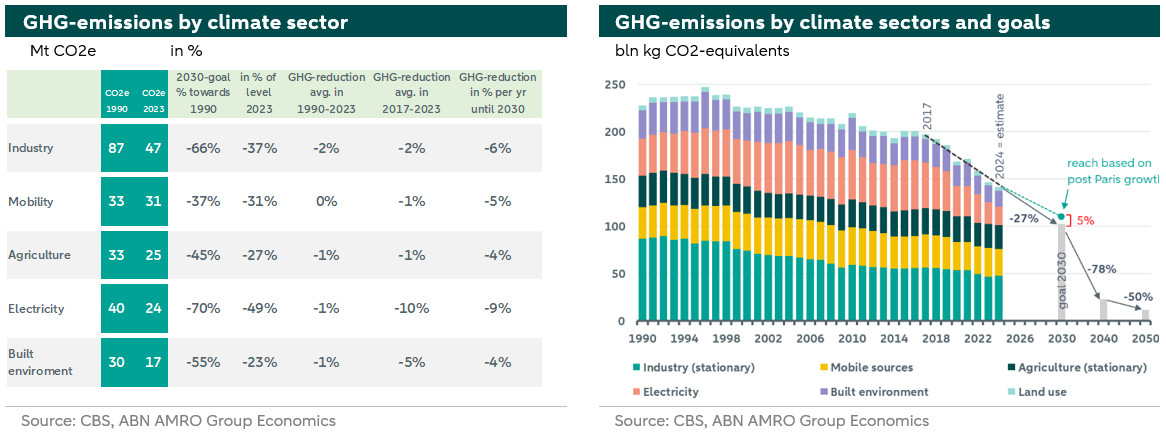
The 2030 climate targets vary by climate sector. For example, the power sector must be 70% below 1990 levels of greenhouse gas emissions by 2030. The climate sector Energy is at the heart of the climate challenge and therefore the percentage is significantly higher than in other climate sectors. Generating electricity and heat by burning fossil fuels causes a large share of greenhouse gases. Prioritising this sector in climate targets is a big part of the solution, as all other climate sectors consume a lot of energy. The largest consumer of energy is industry in the Netherlands. There are many subsectors in this sector in which reducing greenhouse gas emissions is complex (such as in the base metal and chemical industries). The 2030 climate target is also relatively high for the industrial sector.
In its global scenarios, the International Energy Agency (IEA) outlines ambitious targets for each of the climate sectors. In doing so, the agency advises setting short-term milestones for each of the sectors to be able to monitor whether they are on track. Climate policy should ideally be a co-creation between government and the sectors. This creates trust among companies in the sectors themselves, but also among other stakeholders (such as investors, financiers and civil society organisations).
From 2017 - the year the Paris Climate Agreement came into force - greenhouse gas emissions have decreased almost linearly towards 2023, by a total of 26%. All climate sectors contributed to this decrease, but the strongest decline in greenhouse gas emissions was seen in the power sector, where emissions decreased by 51% between 2017 and 2023. Emissions in the built environment were also down above average. Once we extend the recorded initiated trend from 2017-2023 (the post-Paris period) to 2030, emission reduction would fall short of the 2030 target. Ultimately, there is a 5% gap. We use this post-Paris approach in all the climate sectors in this analyses as a benchmark. This is, however, purely a theoretical method and not a base case. After all, past results do not give guarantee about future trends in this case. It is further clear from the right-hand figure above that the biggest climate challenge lies between 2030 and 2040. In this period GHG emissions need te be reduced by 78% in order to reach the 2040 climate target of 90%.
In its recently published Dutch Climate and Energy Outlook (KEV 2024), the Netherlands Environmental Assessment Agency (PBL) shows that the statutory climate target of 55% emission reduction compared to 1990 levels is not going to be met by 2030. PBL concludes that greenhouse gas emissions will fall by 44% to 52% in 2030 compared to 1990, assuming adopted and planned policies (see here our detailed publication on the Dutch KEV 2024).
Problem outline: key challenge per climate sector
Each individual climate sector has its own challenges when it comes to achieving the climate goals towards 2030 and the transition to a low-carbon society. These are often more than one. By understanding and ultimately getting a better grip on the individual challenges or obstacles, we can better interpret the feasibility of climate ambitions. In this part of the analysis, we describe for each climate sector – starting with the sector with the biggest challenge and ending with the sector with the relative small challenge – the most pressing current challenge that ultimately exerts the most influence and impact on their ability to reduce greenhouse gas emissions fast enough.
Climate sector Industry
The key challenge for industry is that the pace of implementing low-carbon production methods in energy-intensive industrial sectors is relatively slow. As high temperatures are required in manufacturing processes, fossil energy consumption is high in industry, especially consumption of gas and oil. More efficient use of energy and also raw materials using clean technologies in industrial sectors that are difficult to decarbonise needs to be scaled up.
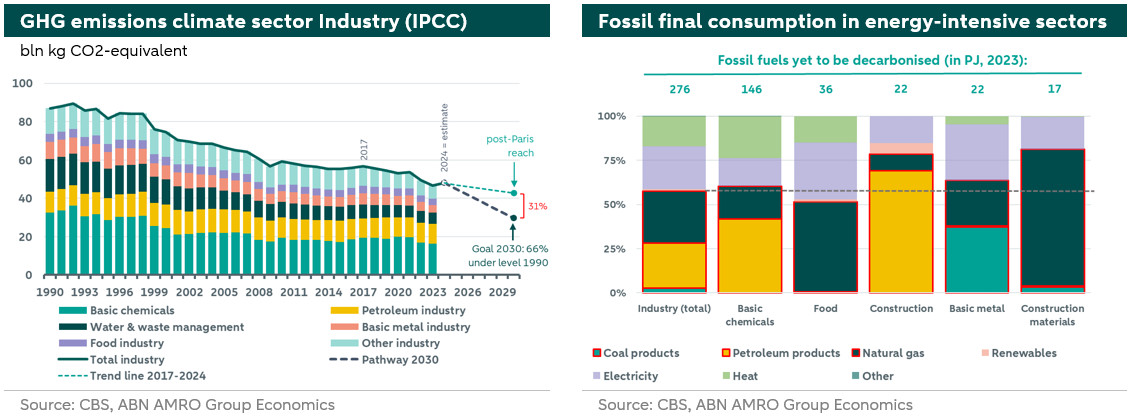
Manufacturing in the Netherlands - according to the IPCC definition, this includes mineral extraction, water utilities, waste and construction - accounts for 34% of total GHG emissions. Basic chemicals (such as making basic chemicals, fertilisers, plastics and rubber) and the petroleum industry account for 35% and 22%, respectively. These two subsectors are thus jointly responsible for more than half of industrial greenhouse gas emissions. In recent years, greenhouse gas emissions have been steadily decreasing through pricing, subsidisation and customised agreements. In the post-Paris 2017-2023 period, GHG emissions decreased by 18%, with the strongest reduction in emissions occurring in the base metal industry (-34%). However, this sharp fall in emissions has more to do with a sharp decline in production over the same period (-26%).
On average, greenhouse gas emissions post-Paris period (2017-now) decreased by 2% per year. If we use this decline as a benchmark for the period 2025 to 2030, the 2030 target will in theory not be reached with a gap of 31%. Thus, more climate action is needed to reach the 2030 target. PBL expects the sector's GHG emissions to reach about 38.5 Mt CO2-e in 2030, based on the policy measures pencilled in. Again, this range is a big difference from the original 2030 climate target. The 2030 target will in this case not be reached with a gap of 23%. According to PBL, the reduction in greenhouse gases between now and 2030 will mainly come from investments in emission reduction projects influenced by pricing in relation to ETS1 and national CO2 tax, but SDE++ subsidies will also contribute.
To further reduce emissions, carbon capture and storage (CCS) is often mentioned among large industrial companies. The importance of hydrogen is also frequently cited here. However, at every level of industry, energy efficiency and electrification offer plenty of greening opportunities. Replacing fossil fuel combustion with electricity could halve industrial emissions, according to estimates. Yet this progress is held back by high investments, higher operational costs and infrastructural problems such as insufficient grid capacity. In addition, electrification of industrial processes is not always easy or at all possible, especially in heavy energy-intensive industries. The bottom line is that decarbonising the most complex industry subsectors is a major transformation of processes, requiring significant investment. Draghi's Competitiveness Report (September 2024) also found that a business case for green technologies is not always transparent. The combination of high investment in green technologies and higher operating costs makes the whole thing uncertain. Despite this uncertainty, low-carbon technologies ultimately bring more industrial specialisation and hence comparative advantages, Draghi said.
Climate sector Agriculture
For agriculture, it is not easy to identify a single challenge, as business activities in this sector are more diverse. Above all, reducing greenhouse gas emissions through low-carbon innovations and more sustainable agricultural production while maintaining revenue models is high on the agenda. Emissions in the agricultural sector are caused by energy use (gas in greenhouse horticulture), by livestock, manure stock and changing land use. Through efficiency measures, sustainable fuels, deployment of renewable energy, green gas from manure fermentation, innovation in feed additives and rationalisation of livestock, more sustainable agricultural production starts to take shape.
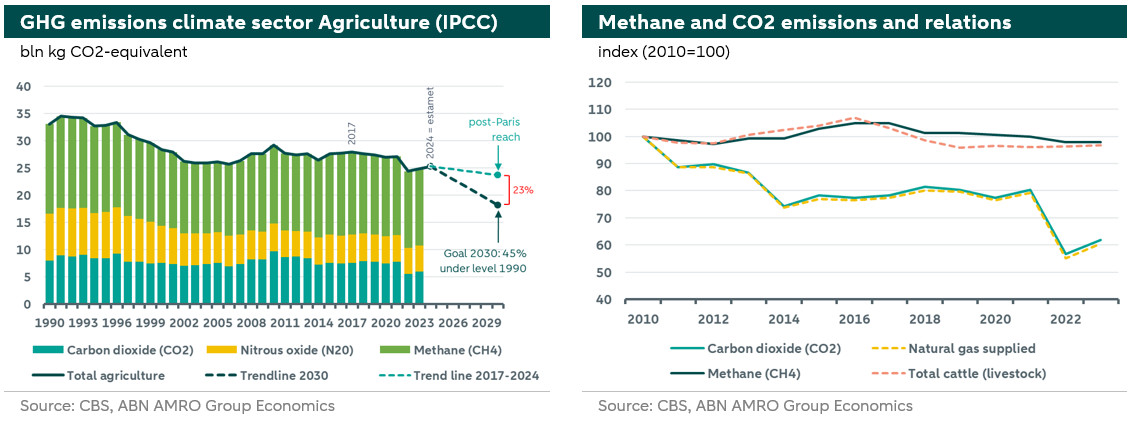
The agricultural sector will be responsible for 24.9 Mt of CO2 equivalents in 2023, equivalent to 18% of the Netherlands' annual greenhouse gas emissions. Until 2030, the sector needs to reduce 6.8 Mt of CO2 equivalents in the intervening years, or almost 27%. In the post-Paris period (2017-now), greenhouse gas emissions in the overall sector have decreased at an average annual rate of 1%. Projecting this rate to the period 2025 to 2030, it becomes clear that the 2030 target will in theory not be reached with a gap of 23%. In its calculations in the base path, PBL assumes that 22 Mt CO2-e is feasible. The decrease in greenhouse gas emissions up to 2030 will be mainly due to less emissions from livestock farming and arable farming, combined with less energy consumption in greenhouse horticulture. This amounts to a 21% gap from the 2030 climate target.
The main focus in the energy tranche will be on greenhouse horticulture (CO2 from gas) and livestock farming (methane from livestock). The right-hand figure above shows, among other things, the relationship between CO2 emissions and the gas supplied to the sector. This delivered gas is mainly destined for greenhouse horticulture for CHP plants. Of the total gas supplied, on average about 75% is used to generate electricity and heat with a CHP plant. The remaining 25% is direct use, e.g. in boilers in greenhouses. Gas consumption has decreased by almost 40% since 2010, which resulted in a drop in CO2 emissions. In particular, the energy crisis in 2021 caused a shock in gas consumption. Currently, the sector is leading the way in deploying renewable energy production techniques such as solar panels, geothermal, biomass plants, windmills, residual heat utilisation and manure digesters on a larger scale. In 2023, the share is still only 9% of final energy consumption, but the transformation to more renewables continues. This helps to further reduce the share of carbon dioxide.
To address methane emissions - with a 57% share of total GHG emissions in agriculture - discussions are ongoing on sharply reducing livestock in the Netherlands. The Netherlands has committed to the Global Methane Pledge, agreeing to reduce methane emissions by 30% by 2030 compared to 2020. Among other things, this goal also affects the agricultural sector. The figure on the right above shows the relationship between methane emissions and livestock (here only cattle) in the Netherlands. The parallel between the two is large. Thus, a decrease in livestock will result in an almost proportional contraction in methane emissions. In the trajectory towards the 2030 climate target, a physical shrinkage of livestock therefore seems almost inevitable, but at the same time innovative feed additives can also help. For instance, there are several innovative feed additives in circulation that have the potential to structurally reduce methane emissions. But it is still proving difficult to determine their advantages and disadvantages and what climate results they really deliver in practice.
Climate sector Mobility
In this sector, the main challenge is to achieve an acceleration in the electrification of road transport combined with an increase in the use of the new generation of clean fuels in waterborne transportation and air transport. Electrification of road transport is increasing every year, but pace in the Netherlands is slow. The challenge is also in the aviation and waterborne transportation sectors, where the reliance on cleaner fuels is relatively high. However, these are to some extent unavailable and also not yet scalable or economically viable.
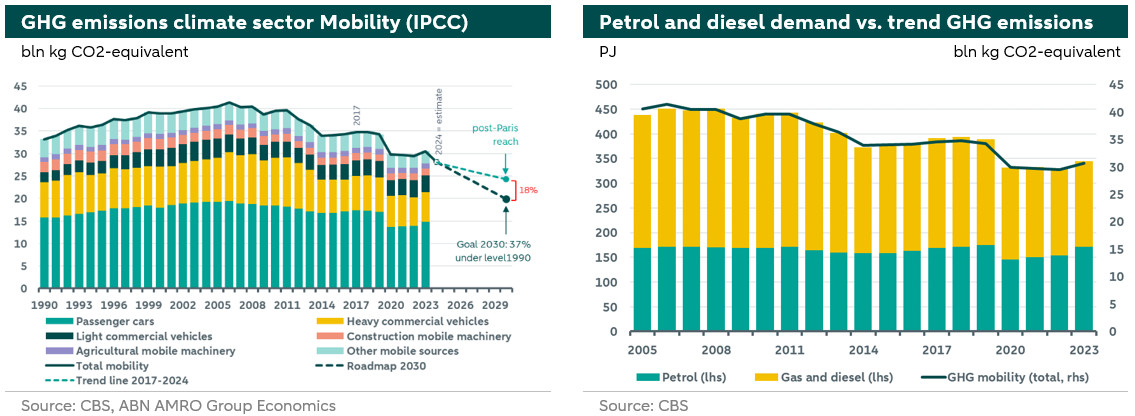
In 2023, the mobility sector was responsible for 30.6 Mt CO2-e of greenhouse gas emissions, most of which are carbon dioxide (CO2) emissions (98%). Road transport is the biggest emitter. It accounts for about 84% of total emissions from the mobility climate sector. Passenger cars emit almost half of total mobility, while light and heavy commercial vehicles are responsible for one-third of emissions.
In the post-Paris period (after 2017), greenhouse gas emissions in the mobility climate sector decreased by 2% per year on average. Immediately after the shock of the corona pandemic - in which the number of transport movements decreased significantly - greenhouse gas emissions did not immediately return to its pre-corona period, helped in part by the energy crisis that followed shortly afterwards. If we assume an average reduction in emissions of 2% a year in the period 2025-2030, the 2030 target will in theory be missed significantly, by a gap of 18%. Also in this climate sector - as in industry and agriculture - more climate measures are needed in the coming years until 2030 to reach the 2030 target. PBL has calculated that GHG emissions from mobility are expected to decrease to around 23.2 Mt CO2-e in 2030 (which implies a gap of 14%), based on adopted and planned policy measures. This is a faster decline in GHG emissions compared to the average rate of decline in the post-Paris period. Underlying this are a faster increase in the number of electric vehicles in road traffic and the increasing use of biofuels.
Consumption of petrol, gas and diesel oil is the main cause of greenhouse gases. Additional measures in that sphere are going to help achieve the climate target. Small-scale initiatives are already under way, such as encouraging home working, efficiency improvements in logistics transport and more public transport trips. Higher-impact measures relate to reducing the average cost of ownership and use (also known as total cost of ownership, including the purchase costs based on the general TCO calculation) of battery-electric vehicles. These costs for a battery-electric vehicle (in this case cars, vans and trucks) are currently not attractive enough compared to petrol and diesel, making the electric vehicles less attractive.
For trucks travelling long distances, battery trucks are making their appearance on the market. The only disadvantage here is that the charging infrastructure is not yet ready. For aviation and navigation, few low-carbon options are currently available. Therefore, companies in these segments will have to buy ETS allowances in the coming years and reduce emissions mainly through efficiency measures. Alternative fuels may become cheaper in the long run if more renewable electricity becomes available to produce them and if, in addition, production is increased significantly. However, this will take time.
Climate sector Built environment
In the built environment, it is not only about scaling up of electrification and energy efficiency measures, but also about accelerating innovation in low-carbon building materials. Decarbonisation takes place in this sector mainly by reducing natural gas consumption. This can be done by electrification (e.g. by installing heat pumps) and by increasing energy efficiency (e.g. by insulation). Decarbonisation of building materials (especially cement and steel) remains complex and takes a long time, due to limited low-carbon production methods.
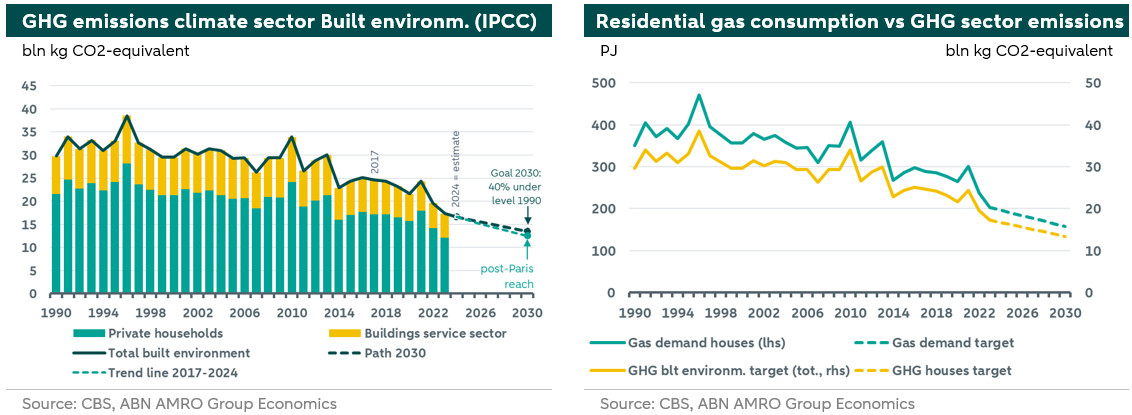
The built environment consists of homes and buildings of companies covered by the service sector. The built environment has a 12% share in the Netherlands' total GHG emissions. Housing accounts for a significant share in these emissions, as it is the largest source of energy consumption and GHG emissions within the built environment. More than 87% of the built environment consists of houses, which puts the share in total greenhouse gas emissions of the built environment at 72% (2023). These greenhouse gas emissions reached their peak in 1996, to gradually - but erratically - decline in the following years.
In the post-Paris period (from 2017 onwards), the sector's greenhouse gas emissions declined at an average annual rate of 5%. Only in the corona year (2021) did emissions increase abruptly, due to lockdowns. If we project the pace from the post-Paris period to the 2025 to 2030 period, the 2030 target may in theory just be met. In its baseline path, PBL assumes that the built environment with its GHG emissions will come out at about 15.6 Mt CO2-e in 2030, which is a gap of 14% with the 2030 climate target. The calculation was made on the basis of known policies for the sector. With this, PBL assumes that the set 2030 climate target for the sector will not be achieved, which seems to imply that the pace of reduction in emissions will slow compared to the post-Paris trend. The decrease in emissions between 2023 and 2030 that PBL projects is mainly due to increases in the number of heat pumps and post-insulation, PBL said.
On balance, it remains difficult to convince residents and users of both residential and non-residential properties to make the climate-neutral transition. In such cases, often the ‘natural’ moments - such as sales, a tenant change or major building maintenance programmes - are the most ideal for implementing emission reduction measures. But then affordability and financing is often a major obstacle in many cases. The government wants the first 1.5 million existing homes to be made more sustainable by 2030. By 2050, 7 million homes and 1 million buildings should be off natural gas. To kick-start the transformation through 2030, the government has created various financial incentives (such as subsidies and interest-free loans) that will lower the initial sustainable investments.
The built environment will continue to be responsible for a significant share of energy consumption, natural resource use, waste generation and greenhouse gas emissions. This will particularly apply to existing buildings. There is no single panacea for this sector to achieve the goal of carbon-free buildings. The carbon-free trajectory will continue to depend on a combination of reduction in gas usage, different sustainability measures and decarbonisation technologies. Government regulation, policy and new standards will also remain key to driving and accelerating the low-carbon transition.
Climate sector Electricity
In the energy sector, it is important to remove bottlenecks hindering the deployment of clean power in the electricity mix. Switching from conventional fossil based power generation to carbon free sources makes the biggest contribution to emission reduction. However, the deployment of more clean energy is hampered by the high investments needs, slow grid capacity build-out, backlogs in grid connections for business, access to cheap finance, and lengthy permitting procedures.

In 2023, the electricity sector was responsible for 23.5 Mt CO2-e of greenhouse gas emissions. This is 14% of total greenhouse gas emissions in the Netherlands. Since the last peak in 2015 - when the sector still had a 26% share of total emissions - greenhouse gas emissions have fallen sharply. Over eight years (2015-2023), emissions fell by 56%. In the first half of 2024, emissions have now fallen by 18% year-on-year. The sharp decline is in line with the ambition of the Climate Accord, in which it has been agreed that by 2030 the share of renewable electricity in total electricity production will be 70%. The sector is well on its way to achieving this target. Recently, CBS reported that electricity production from renewable sources continued to increase in the first half of 2024 and now accounts for 53% of total electricity production. The increase was mainly due to the surge in electricity production from both offshore and onshore wind.
If we apply the average reduction in greenhouse gas emissions over the post-Paris period (2017-2023) to the period 2024 to 2030, the pace of reduction could in theory be sufficient to meet the set climate target in 2030. The sector is committed to growing the share of renewable energy from wind and solar, replacing electricity generation from fossil fuels with CO2-free fuels and nuclear power, for example. In its KEV 2024, PBL assumes a decline in greenhouse gas emissions to a level of 10 to 20 Mt CO2-e in 2030. PBL's calculation is based on adopted and planned policies The decrease is mainly driven by the closure of coal-fired power plants from 2030 and the phasing out of coal use. Next to that, PBL thinks that the sharp increase in renewable energy (solar and wind power) and more sustainable measures of Tata Steel is going to have a positive effect on the electricity sector. This means a delay in the average emission reduction over the post-Paris period in the years up to 2030. In addition, both grid congestion and developments in the European electricity market have a great impact on the final greenhouse gas emissions. This reduces the likelihood of the power sector meeting its 2030 climate target.
The biggest obstacle in the Netherlands is that the congestion in the electricity grid is becoming more severe, while electricity generation and demand for it are only increasing. For example, there is a delay to provide new solar installations or wind turbines with a connection to the grid. There may also be a waiting list for new or existing users to use more electricity. Grid congestion is not continuous, but occurs at peak times during the day. It is also often a local or regional problem. Ultimately, grid congestion problems in the power sector are a major obstacle for all other climate sectors. The core of the solution and acceleration towards 2030 therefore lies in the energy sector. The most obvious way to tackle grid congestion is grid reinforcement. However, grid reinforcement takes a lot of time and investment. To cope with the current problems of grid congestion, solutions in the areas of management of electricity supply (large scale storage) and demand (demand response) and reducing grid dependence can be sought, among others.
Conclusion
The 2030 climate target for the Netherlands is for emissions to decline to a level of 103 Mt CO2-e. Based on the post-Paris trend in greenhouse gas emission reductions, we could be heading for a level of 108 Mt CO2-e in 2030. This eventually creates a gap of about 5% in 2030. According to PBL, GHG emissions in the Netherlands - based on adopted and planned policies - fall to a level of 110-127 Mt CO2-e in 2030 in the base case. The range is wide, but on average the Netherlands will not meet its 2030 climate target, with a gap of about 12%. This implies a slowdown in the average post-Paris emission reduction trend.
Based on the average post-Paris emission reduction trend (2017-2023), the climate sectors ‘built environment’ and ‘electricity’ might be able to meet the set 2030 climate target. However, past results are no guarantee for the future. In addition, the Netherlands has experienced two severe system shocks in the post-Paris period (pandemic and energy crisis), which cloud the trend figures. PBL's calculations based on known policies for the climate sectors show that no climate sector will eventually meet its stated 2030 climate target. For that, climate measures fall well short.The carbon intensity of many companies in sectors depends heavily on the carbon footprint of electricity production. Then greening the energy mix is key to greening businesses in other sectors and thus deserves the highest priority. In many cases, addressing the biggest challenge by climate sector can start well once the biggest obstacles in the energy sector have been removed.
Moreover, electrification is a widely used strategy by many companies to become more carbon efficient, aiming to replace fossil energy. It is not the silver bullet, but electrification can contribute significantly to further greening the economy. A green energy mix for electricity generation is also an important prerequisite from this point of view.

